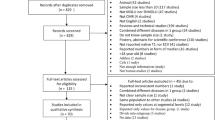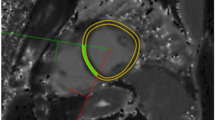Abstract
Myocardial iron quantification remains limited to 1.5 T systems with T2* measurement. The present study aimed at comparing myocardial T2* values at 1.5 T to T1 and T2 mapping at 3.0 T in patients with iron overload and healthy controls. A total of 17 normal volunteers and seven patients with a history of myocardial iron overload were prospectively enrolled. Mid-interventricular septum T2*, native T1 and T2 times were quantified on the same day, using a multi-echo gradient-echo sequence at 1.5 T and T1 and T2 mapping sequences at 3.0 T, respectively. Subjects with myocardial iron overload (T2* < 20 ms) in comparison with those without had significantly lower mean myocardial T1 times (868.9 ± 120.2 vs. 1170.3 ± 25.0 ms P = 0.005 respectively) and T2 times (34.9 ± 4.7 vs. 45.1 ± 2.0 ms P = 0.007 respectively). 3 T T1 and T2 times strongly correlated with 1.5 T, T2* times (Pearson’s r = 0.95 and 0.91 respectively). T1 and T2 measures presented less variability than T2* in inter- and intra-observer analysis. Native myocardial T1 and T2 times at 3 T correlate closely with T2* times at 1.5 T and may be useful for myocardial iron overload quantification.

Similar content being viewed by others
References
Camaschella C, Poggiali E. Inherited disorders of iron metabolism. Curr Opin Pediatr. 2011;23:14–20.
Murphy CJ, Oudit GY. Iron-overload cardiomyopathy: pathophysiology, diagnosis, and treatment. J. Card. Fail. 2010;16:888–900.
Kolnagou A, Yazman D. Uses and limitations of serum ferritin, magnetic resonance imaging T2 and T2* in the diagnosis of iron overload and in the ferrikinetics of normalization of the iron stores in thalassemia using international committe on chelation deferiprone/deferoxamine. Hemoglobin. 2009;33:312–22.
Pennell DJ. T2* magnetic resonance and myocardial iron in thalassemia. Ann N Y Acad Sci. 2005;378:373–8.
Pennell DJ, Udelson JE, Arai AE, Bozkurt B, Cohen AR, Galanello R, et al. Cardiovascular function and treatment in β-thalassemia major: a consensus statement from the american heart association. Circulation. 2013;128:281–308.
Modell B, Khan M, Darlison M, Westwood MA, Ingram D, Pennell DJ. Improved survival of thalassaemia major in the UK and relation to T2* cardiovascular magnetic resonance. J Cardiovasc Magn Reson BioMed Central. 2008;10:42.
Wood JC, Otto-Duessel M, Aguilar M, Nick H, Nelson MD, Coates TD, et al. Cardiac iron determines cardiac T2*, T2, and T1 in the gerbil model of iron cardiomyopathy. Circulation. 2005;112:535–43.
Carpenter J-P, He T, Kirk P, Roughton M, Anderson LJ, De Noronha SV, et al. On T2* magnetic resonance and cardiac iron. Circulation. 2011;123:1519–28.
Wood J. History and current impact of cardiac magnetic resonance imaging on the management of iron overload. Circulation. Lippincott Williams & Wilkins; 2009;123:2552–61.
Storey P, Thompson A. R2* Imaging of Transfusional Iron Burden at 3T and Comparison with 1.5 T. J Magn Reson Imaging NIH Public Access. 2007;25:540–7.
He T, Smith GC, Gatehouse PD, Mohiaddin RH, Firmin DN, Pennell DJ. On using T2 to assess extrinsic magnetic field inhomogeneity effects on T2* measurements in myocardial siderosis in thalassemia. Magn Reson Med. 2009;61:501–6.
Oshinski JN, Delfino JG, Sharma P, Gharib AM, Pettigrew RI. Cardiovascular magnetic resonance at 3.0 T: current state of the art. J Cardiovasc Magn Reson BioMed Central Ltd. 2010;12:55.
Messroghli DR, Greiser A, Fröhlich M, Dietz R, Schulz-Menger J. Optimization and validation of a fully-integrated pulse sequence for modified look-locker inversion-recovery (MOLLI) T1 mapping of the heart. J Magn Reson Imaging. 2007;26:1081–6.
Messroghli DR, Radjenovic A, Kozerke S, Higgins DM, Sivananthan MU, Ridgway JP. Modified look-locker inversion recovery (MOLLI) for high-resolution T1 mapping of the heart. Magn Reson Med. 2004;52:141–6.
Giri S, Shah S, Xue H, Chung Y-C, Pennell ML, Guehring J, et al. Myocardial T2 mapping with respiratory navigator and automatic nonrigid motion correction. Magn Reson Med. 2012;68:1570–8.
Henninger B, Kremser C, Rauch S, Eder R, Zoller H, Finkenstedt A, et al. Evaluation of MR imaging with T1 and T2* mapping for the determination of hepatic iron overload. Eur Radiol. 2012;22:2478–86.
Feng Y, He T, Carpenter J-P, Jabbour A, Alam MH, Gatehouse PD, et al. In vivo comparison of myocardial T1 with T2 and T2* in thalassaemia major. J Magn Reson Imaging. 2013;38:588–93.
Sado D, White SK, Piechnik SK, Banypersad SM, Treibel TA, Fontana M, et al. Native T1 lowering in iron overload and Anderson Fabry disease ; a novel and early marker of disease. J Cardiovasc Magn Reson BioMed Central Ltd. 2013;15(Suppl1):O71 (Abstract).
Lee JJ, Liu S, Nacif MS, Ugander M, Han J, Kawel N, et al. Myocardial T1 and extracellular volume fraction mapping at 3 tesla. J Cardiovasc Magn Reson. 2011;13:75.
Piechnik S, Ferreira V, Armellina E, Cochlin L, Greiser A, Neubauer S, et al. Shortened Modified Look-Locker Inversion recovery (ShMOLLI) for clinical myocardial T1-mapping at 1.5 and 3 T within a 9 heartbeat breathhold. J Cardiovasc Magn Reson. 2010;1:11.
Westwood Mark. Lisa J Anderson, David N Firmin, Peter D Gatehouse, Clare C Charrier, Beatrix Wonke DJP. A single breath-hold multiecho T2* cardiovascular magnetic resonance technique for diagnosis of myocardial iron overload. J Magn Reson Imaging. 2003;18:33–9.
Giri S, Chung Y-C, Merchant A, Mihai G, Rajagopalan S, Raman SV, et al. T2 quantification for improved detection of myocardial edema. J. Cardiovasc. Magn. Reson. [Internet]. 2009 [cited 2013 May 28];11:56. Available from: http://www.pubmedcentral.nih.gov/articlerender.fcgi?artid=2809052&tool=pmcentrez&rendertype=abstract.
Kellman P, Chefd’hotel C, Lorenz CH, Mancini C, Arai AE, McVeigh ER. High spatial and temporal resolution cardiac cine MRI from retrospective reconstruction of data acquired in real time using motion correction and resorting. Magn Reson Med. 2009;62:1557–64.
He T, Gatehouse PD, Smith GC, Mohiaddin RH, Pennell DJ, Firmin DN. Myocardial T2* measurements in iron-overloaded thalassemia: an in vivo study to investigate optimal methods of quantification. Magn Reson Med. 2008;60:1082–9.
Hardy P, Henkelman R. Transverse relaxation rate enhancement caused by magnetic particulates. Magn Reson Imaging. 1989;7:265–75.
Tanimoto a, Oshio K, Suematsu M, Pouliquen D, Stark DD. Relaxation effects of clustered particles. J. Magn. Reson. Imaging. 2001;14:72–7.
Gossuin Y, Burtea C, Monseux A, Toubeau G, Roch A, Muller RN, et al. Ferritin-induced relaxation in tissues: an in vitro study. J Magn Reson Imaging. 2004;20:690–6.
Anderson LJ, Holden S, Davis B, Prescott E, Charrier CC, Bunce NH, et al. Cardiovascular T2-star (T2*) magnetic resonance for the early diagnosis of myocardial iron overload. Eur. Heart J. W B Saunders Co Ltd; 2001;22:2171–9.
Ibrahim E-SH, Rana FN, Johnson KR, White RD. Assessment of cardiac iron deposition in sickle cell disease using 3.0 Tesla cardiovascular magnetic resonance. Hemoglobin. 2012;36:343–61.
Liu S, Han J, Nacif M, Jones J, Kawel N, Kellman P, et al. Diffuse myocardial fibrosis evaluation using cardiac magnetic resonance T1 mapping: sample size considerations for clinical trials. J Cardiovasc Magn Reson. 2012;14:90.
Guo H, Au W, Cheung J. Myocardial T2 Quantitation in Patients With Iron Overload at 3 Tesla. J Magn NIH Public Access. 2009;22:4109.
Von Knobelsdorff-Brenkenhoff F, Prothmann M, Dieringer M a, Wassmuth R, Greiser A, Schwenke C, et al. Myocardial T1 and T2 mapping at 3 T: reference values, influencing factors and implications. J. Cardiovasc. Magn. Reson. [Internet]. Journal of Cardiovascular Magnetic Resonance; 2013 [cited 2014 Jul 26];15:53. Available from: http://www.pubmedcentral.nih.gov/articlerender.fcgi?artid=3702448&tool=pmcentrez&rendertype=abstract.
Chu WCW, Au WY, Lam WWM. MRI of cardiac iron overload. J Magn Reson Imaging. 2012;36:1052–9.
Wu E, Kim D, Tosti C. Magnetic resonance assessment of iron overload by separate measurement of tissue ferritin and hemosiderin iron. Ann New Acad Sci NIH Public Access. 2010;1202:115–22.
Cheung J, Au W, Ha S. Reduced Transverse Relaxation Rate (RR2) for Improved Sensitivity in Monitoring Myocardial Iron in Thalassemia. J Magn Reson Imaging NIH Public Access. 2011;33:1510–6.
Carpenter JP, Pennell DJ. Role of T2* magnetic resonance in monitoring iron chelation therapy. Acta Haematol. 2009;122:146–54.
Kirk P, Carpenter JP, Tanner M a, Pennell DJ. Low prevalence of fibrosis in thalassemia major assessed by late gadolinium enhancement cardiovascular magnetic resonance. J Cardiovasc Magn Reson BioMed Central Ltd; 2011;13:8.
Marks B, Mitchell DG, Simelaro JP. Breath-holding in healthy and pulmonary-compromised populations: effects of hyperventilation and oxygen inspiration. J Magn Reson Imaging. 1997;7:595–7.
Robson MD, Piechnik SK, Tunnicliffe EM, Neubauer S. T1 measurements in the human myocardium: the effects of magnetization transfer on the SASHA and MOLLI sequences. Magn Reson Med. 2013;00:1–7.
Chow K, Flewitt J a, Green JD, Pagano JJ, Friedrich MG, Thompson RB. Saturation recovery single-shot acquisition (SASHA) for myocardial T1 mapping. Magn Reson Med 2013;00:1–14.
Acknowledgments
This research was conducted with no external sources of funding. The authors AG and RS are Siemens employees and provided technical support to this research. They were not involved in the study design, data collection, interpretation and reporting.
Author information
Authors and Affiliations
Corresponding author
Ethics declarations
Conflict of interest
All other authors declared no competing interests.
About this article
Cite this article
Camargo, G.C., Rothstein, T., Junqueira, F.P. et al. Comparison of myocardial T1 and T2 values in 3 T with T2* in 1.5 T in patients with iron overload and controls. Int J Hematol 103, 530–536 (2016). https://doi.org/10.1007/s12185-016-1950-1
Received:
Revised:
Accepted:
Published:
Issue Date:
DOI: https://doi.org/10.1007/s12185-016-1950-1




